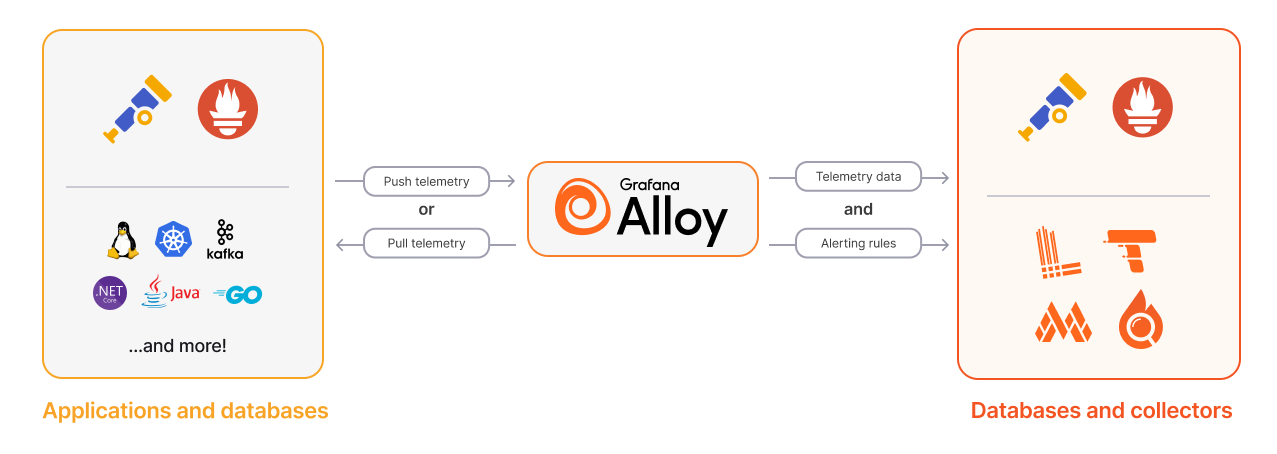Alloy configuration syntax
Grafana Alloy dynamically configures and connects components with the Alloy configuration syntax. Alloy handles the collection, transformation, and delivery of telemetry data. Each component in the configuration handles one of those tasks or specifies how data flows and how the components are bound together.

The following simple example shows the basic concepts and how an Alloy configuration comes together into a pipeline.
// Collection: mount a local directory with a certain path spec
local.file_match "applogs" {
path_targets = [{"__path__" = "/tmp/app-logs/app.log"}]
}
// Collection: Take the file match as input, and scrape those mounted log files
loki.source.file "local_files" {
targets = local.file_match.applogs.targets
// This specifies which component should process the logs next, the "link in the chain"
forward_to = [loki.process.add_new_label.receiver]
}
// Transformation: pull some data out of the log message, and turn it into a label
loki.process "add_new_label" {
stage.logfmt {
mapping = {
"extracted_level" = "level",
}
}
// Add the value of "extracted_level" from the extracted map as a "level" label
stage.labels {
values = {
"level" = "extracted_level",
}
}
// The next link in the chain is the local_loki "receiver" (receives the telemetry)
forward_to = [loki.write.local_loki.receiver]
}
// Anything that comes into this component gets written to the loki remote API
loki.write "local_loki" {
endpoint {
url = "http://loki:3100/loki/api/v1/push"
}
}The Alloy syntax aims to reduce errors in configuration files by making configurations easier to read and write. The Alloy syntax uses blocks, attributes, and expressions. The blocks can be copied and pasted from the documentation to help you get started as quickly as possible.
The Alloy syntax is declarative, so ordering components, blocks, and attributes does not matter. The relationship between components determines the order of operations in the pipeline.
Blocks
You use Blocks to configure components and groups of attributes. Each block can contain any number of attributes or nested blocks. Blocks are steps in the overall pipeline expressed by the configuration.
prometheus.remote_write "default" {
endpoint {
url = "http://localhost:9009/api/prom/push"
}
}The preceding example has two blocks:
prometheus.remote_write "default": A labeled block which instantiates aprometheus.remote_writecomponent. The label is the string"default".endpoint: An unlabeled block inside the component that configures an endpoint to send metrics to. This block sets theurlattribute to specify the endpoint.
Attributes
You use Attributes to configure individual settings.
Attributes always take the form of ATTRIBUTE_NAME = ATTRIBUTE_VALUE.
The following example shows how to set the log_level attribute to "debug".
log_level = "debug"Expressions
You use expressions to compute the value of an attribute.
The simplest expressions are constant values like "debug", 32, or [1, 2, 3, 4].
The Alloy syntax supports complex expressions, for example:
- Referencing the exports of components:
local.file.password_file.content - Mathematical operations:
1 + 2,3 * 4,(5 * 6) + (7 + 8) - Equality checks:
local.file.file_a.content == local.file.file_b.content - Calling functions from Alloy’s standard library:
env("HOME")retrieves the value of theHOMEenvironment variable.
You can use expressions for any attribute inside a component definition.
Referencing component exports
The most common expression is to reference the exports of a component, for example, local.file.password_file.content.
You form a reference to a component’s exports by merging the component’s name (for example, local.file),
label (for example, password_file), and export name (for example, content), delimited by a period.
Configuration syntax design goals
Alloy is:
- Fast: The configuration language is fast, so the component controller can quickly evaluate changes.
- Simple: The configuration language is easy to read and write to minimize the learning curve.
- Easy to debug: The configuration language gives detailed information when there’s a mistake in the configuration file.
The Alloy configuration syntax is a distinct language with custom syntax and features, such as first-class functions.
- Blocks are a group of related settings and usually represent creating a component.
Blocks have a name that consists of zero or more identifiers separated by
., an optional user label, and a body containing attributes and nested blocks. - Attributes appear within blocks and assign a value to a name.
- Expressions represent a value, either literally or by referencing and combining other values. You use expressions to compute a value for an attribute.
Tooling
You can use one or all of the following tools to help you write Alloy configuration files.
- Editor support for:
- Code formatting using the
alloy fmtcommand
Was this page helpful?
Related documentation
Related resources from Grafana Labs



